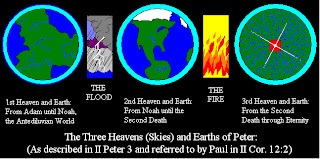Shalom, everyone.
Now, let’s spend some time with the 12 different foundations. As I’ve already said, I believe that these are twelve foundational LEVELS to the city, each foundational level the foundation for more buildings and streets and parks within the city. Remember: it is a three-dimensional city, and God is perfectly efficient and is not the sort to waste space.
19 And the foundations of the wall of the city were garnished with all manner of precious stones. The first foundation was jasper; the second, sapphire; the third, a chalcedony; the fourth, an emerald;
20 The fifth, sardonyx; the sixth, sardius; the seventh, chrysolite; the eighth, beryl; the ninth, a topaz; the tenth, a chrysoprasus; the eleventh, a jacinth; the twelfth, an amethyst.
We’ve already discussed the first foundation of jasper: in summary, I believe it to be a blood-red, transparent chalcedony (microcrystalline quartz).
The second foundation is said to be a sapphire. The Greek word is “sapfeiros” which was typically the word used for lapis lazuli, a bright royal-blue rock. Wikipedia says:
Description
The main component of lapis lazuli is lazurite (25% to 40%), a feldspathoid silicate mineral with the formula (Na,Ca)8(AlSiO4)6(S,SO4,Cl)1-2.[4] Most lapis lazuli also contains calcite (white), sodalite (blue), and pyrite (metallic yellow). Other possible constituents: augite; diopside; enstatite; mica; hauynite; hornblende, and nosean. Some lapis lazuli contains trace amounts of the sulfur-rich löllingite variety geyerite.
Lapis lazuli usually occurs in crystalline marble as a result of contact metamorphism.
[edit] Etymology
Lapis is the Latin for "stone" and lazuli the genitive form of the Medieval Latin lazulum, which is taken from the Arabic لازورد lāzaward, which is from the Persian لاژورد lāzhward, the name of a place where lapis lazuli was mined.[5][6] Taken as a whole, lapis lazuli means "stone of Lāzhward".
The name of the place came to be associated with the stone mined there and, eventually, with its color. The English word azure, the French azur, the Italian azzurro, the Polish lazur and the Spanish and Portuguese azul are cognates.
So, this stone is a beautiful blue color.
The third foundation is said to consist of chalcedony. I don’t know what color this will be; there are so many varieties! For an interesting (and quite beautiful) picture of these varieties, see http://www.bernardine.com/gemstones/chalcedony.htm. I personally lean toward the lavender, light blue, or chrysocolla forms, but that’s just a preference and I have no scriptural backing for my choices. It could even be the tiger’s eye or black onyx varieties. All I know for sure is that it is not the green chrysoprase or the sardonyx varieties as they are already individually named in verse 20.
The fourth foundation consists of emerald (Greek: smaragdos), and I believe this to be true emerald since they already were being used in
The fifth foundation consists of sardonyx, which is seen in the picture provided at the bernardine.com website listed above. It is usually a striped stone with alternating reddish-brown and yellow or white stripes.
The sixth foundation consists of sard or carnelian. This is a deep reddish-brown variety of chalcedony, and the darker form is generally harder and tougher.
It is interesting that Yochanan (John) describes the One sitting upon the throne was “to look upon like a jasper (blood-red) or a sardine (sard-like, reddish-brown) stone” (Rev. 4:3).
The seventh foundation consists of chrysolite (Greek: “chrusolithos” = “gold-stone”). There is such a type of stone that is actually a glittering glass seemingly with flecks of gold embedded in the glass; I have one. But, I feel that this makes it unlikely to be an actual “goldstone.” Most “chrysolite” is actually a “chrusoberyl.” It may be the yellow or yellow-green varieties, Alexandrite, or the cymophane or “cat’s eye.” I believe that it will be the yellow variety (“GOLD-stone”), but the possibility that it could be the “cat’s eye” intrigues me.
The eighth foundation consists of beryl, but beryl comes is a variety of shades: pink morganite, blue aquamarine, green heliodor and even a raspberry-red beryl, but the type highly appraised in the ancient world was the golden beryl.
The ninth foundation consists of a topaz. Topazes primarily come in two colors, yellow and blue, but they can also come in red, dark red, orange, golden, and colorless varieties.
Again, this is purely a preference, but I favor the blue variety.
The tenth foundation consists of chrysoprase, which we’ve already touched on a little. This is generally an apple-green variety of chalcedony based on nickel impurities, but it is a cryptocrystalline form of silica more like agates, carnelian, and onyx in that they are non-transparent and lacking of large crystals.
The eleventh foundation is called “a jacinth” (Greek: “huakinthos”) also called a “hyacinth,” when the Greek is transliterated, but usually the “hyacinth” refers to the blue flower while the “jacinth” is an orange gemstone.
The twelfth and final foundation is the amethyst (Greek: “amethustos”), which is the lavender to purple gemstone.
Each of these foundational level are reduced by a thousand furlongs east and west and by a thousand furlongs north and south, as they climb through the city. That means that the first foundation would have the full dimensions of the city’s length and width, 12,000 furlongs by 12,000 furlongs (1,500 mi x 1,500 mi). The second foundation would be reduced to 11,000 furlongs by 11,000 furlongs (1,375 mi x 1,375 mi), and so forth.
The final foundation would be 1,000 furlongs by 1,000 furlongs (125 mi x 125 mi). Calculating it all out, this would provide over ten million square miles of building space (10,156,250 sq. mi.)!
That’s enough for tonight.
In the Messiah’s love,
Retrobyter

